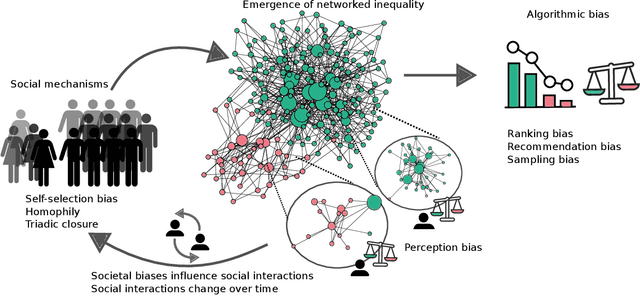Fariba Karimi
hyperFA*IR: A hypergeometric approach to fair rankings with finite candidate pool
Jun 17, 2025Abstract:Ranking algorithms play a pivotal role in decision-making processes across diverse domains, from search engines to job applications. When rankings directly impact individuals, ensuring fairness becomes essential, particularly for groups that are marginalised or misrepresented in the data. Most of the existing group fairness frameworks often rely on ensuring proportional representation of protected groups. However, these approaches face limitations in accounting for the stochastic nature of ranking processes or the finite size of candidate pools. To this end, we present hyperFA*IR, a framework for assessing and enforcing fairness in rankings drawn from a finite set of candidates. It relies on a generative process based on the hypergeometric distribution, which models real-world scenarios by sampling without replacement from fixed group sizes. This approach improves fairness assessment when top-$k$ selections are large relative to the pool or when protected groups are small. We compare our approach to the widely used binomial model, which treats each draw as independent with fixed probability, and demonstrate$-$both analytically and empirically$-$that our method more accurately reproduces the statistical properties of sampling from a finite population. To operationalise this framework, we propose a Monte Carlo-based algorithm that efficiently detects unfair rankings by avoiding computationally expensive parameter tuning. Finally, we adapt our generative approach to define affirmative action policies by introducing weights into the sampling process.
Minorities in networks and algorithms
Jun 14, 2022
Abstract:In this chapter, we provide an overview of recent advances in data-driven and theory-informed complex models of social networks and their potential in understanding societal inequalities and marginalization. We focus on inequalities arising from networks and network-based algorithms and how they affect minorities. In particular, we examine how homophily and mixing biases shape large and small social networks, influence perception of minorities, and affect collaboration patterns. We also discuss dynamical processes on and of networks and the formation of norms and health inequalities. Additionally, we argue that network modeling is paramount for unveiling the effect of ranking and social recommendation algorithms on the visibility of minorities. Finally, we highlight the key challenges and future opportunities in this emerging research topic.
 Add to Chrome
Add to Chrome Add to Firefox
Add to Firefox Add to Edge
Add to Edge